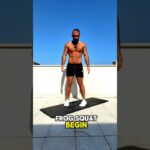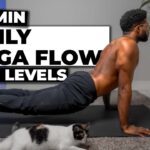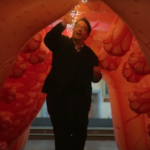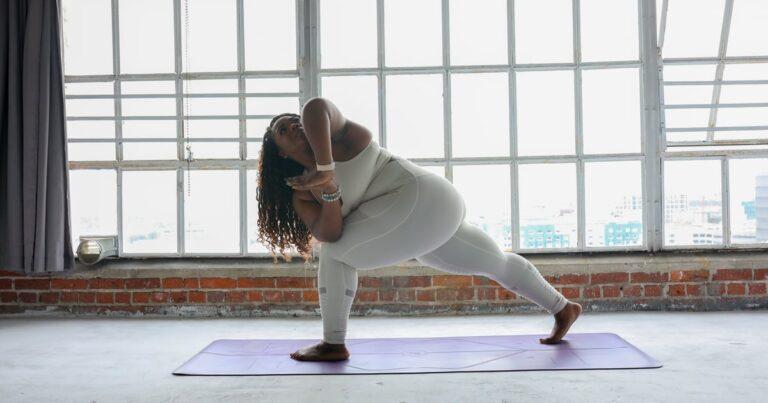The last thing you want to do when you have a cold (or, god forbid, the flu) is think about exercising. Your nose is congested, your throat aches, your sinuses are about to explode … it’s probably all you can do to get up for a mug of tea, let alone work out. So it might surprise you to hear that one type of exercise might actually help when you have a cold or mild flu: yoga.
“Gentle and restorative yoga can be beneficial during a cold,” yoga teacher Bayu Prihandito, RYT-200, tells SheKnows. That’s because yoga can help you relax and improve circulation, he explains, and even potentially relieve some of your symptoms. And while you should continue to take your usual go-to cold relief products (yoga can’t fix everything), it’s true that science also backs up yoga’s feel-good power. A 2018 review found that a regular yoga practice is linked to reduced inflammation in the body, suggesting it may work as a “complementary intervention” for people at risk for inflammatory diseases (think: rheumatoid arthritis, heart disease, inflammatory bowel disease, and more.)
That said, if you’re feeling fatigued or have a high temperature, it’s best to prioritize rest over yoga, no matter how gentle your poses are. “Always listen to your body,” Prihandito says. If you do decide to get on the mat, yoga teacher Antionette Pollard recommends practicing for no longer than 10 to 15 minutes and avoiding an indoor yoga class so you don’t get others sick. Opt for a slow, gentle at-home practice and start with the eight expert-recommended poses below.
Child’s Pose
“This pose allows for gentle compression on the sinus area, which can help relieve congestion,” Prihandito says. Folding forward also “promotes relaxation and eases tension,” he adds. He recommends using props like a bolster or pillow to ensure your body is fully supported, which will let you relax even further.
Here’s how to do Child’s Pose:
- Start on your hands and knees, with your knees below your hips and hands below your shoulders.
- Slide your feet together so your toes are touching and gently push your body back until your butt touches your feet, keeping your arms straight out in front of you. You can keep your knees wide apart or close together, whichever feels more comfortable.
- Let your head and chest sink towards the ground, resting your forehead on the ground as you feel a gentle stretch in your hips, shoulders, and back. You can place a pillow or bolster under your chest or forehead for extra support.
Legs Up the Wall
This gentle, super-relaxing inversion promotes circulation by encouraging blood flow back to the heart, Prihandito explains. This can help with drainage and provide some relief from congestion. To modify this pose (and make it even more easeful), yoga instructor Teresa Adele, 200-RYT, recommends resting your legs on a chair instead.
Here’s how to do Legs Up the Wall:
-
Sit sideways next to a wall, placing your butt as close to the base of the wall as you can.
-
Recline onto your back and straighten your legs up the wall, reaching your feet toward the ceiling. Place your arms out to either side and relax into the pose, holding for as long as you want.
Bridge Pose
Want to open up your chest and lungs? This is the pose Prihandito recommends. Lifting the chest allows for better airflow, he says, and “can help in clearing mucus,” while the gentle backbend can stimulate your thymus gland, an organ that’s “critically important” to your immune system, according to experts.
Here’s how to do Bridge Pose:
- Lie flat on your back with your arms by your sides.
- Bend your knees and plant your feet flat on the floor, bringing your heels as close to your butt as you can.
- Press your palms into the floor and lift your hips off the ground and toward the ceiling. Continue to push through your feet and lift your hips as high as you can.
- To open up your chest even more, clasp your hands together to form a fist.
- To come down, slowly roll your spine back down to the floor.
Seated Twist Pose
This simple post “activates both the digestive and lymphatic system,” Pollard says, which promotes the movement of toxins through and out of your body.
Here’s how to do Seated Twist Pose:
- Sit on the floor with your spine straight and your legs extended out in front of you.
- Bend your right knee and bring it in toward your chest, placing the heel as close to your body as you can.
- Then, cross your bent right leg over your left thigh. Keep your left leg extended out in front of you or, if you want more of a twist, bend it under your body in the opposite direction.
- Place your right hand close behind your back and reach your left arm up and then over to the right side. Bend your left elbow and place it on the outside of your right knee.
- Twist your spine and neck so you’re looking over your right shoulder, toward the back of the room.
- Repeat on the other side, holding for an equal amount of time on both sides.
Cobra Pose
Cobra pose encourages deep breathing, which is great for improving your lung capacity and function, Pollard says. This pose is a little more strenuous on your shoulders and arms, so only hold it for as long as it’s comfortable.
Here’s how to do Cobra Pose:
- Start by lying flat on your stomach with your forehead on the floor.
- Place your hands beneath your shoulders and gently press through your palms to lift your chest and head off the ground. Roll your shoulders back and down and keep your neck long instead of lifting your chin.
- You can bend your elbows for more support or straighten them to open your chest further.
- Come out of the pose by lowering back down to your starting position, or pushing back into Child’s Pose.
Dolphin Pose
Dolphin pose is another one that’s slightly tougher on your upper body, but can be very relaxing when you nail the position. Pollard recommends it for its ability to increase blood circulation and help alleviate sinus pressure.
Here’s how to do Dolphin Pose:
- Start on your hands and knees, with your knees under your hips and hands below your shoulders.
- Lower your forearms to the ground so that your elbows align with your shoulders. Clasp your hands while firmly pressing your forearms into the floor.
- Lift your knees from the floor, making sure to keep your back flat. You can straighten your legs or keep your knees bent — go for the latter option if you feel your back wanting to round.
- Continue pressing your forearms into the floor and drawing your shoulders down your spine. Hold your head steady between your upper arms.
- To come out of the pose, bend your legs and set your knees on the floor.
Supported Fish Pose
Supported fish pose “opens up the spine and may make breathing feel easier by stretching the muscles in the ribcage around the lungs,” Adele tells SheKnows.
Here’s how to do Supported Fish Pose:
- Set a bolster, firm pillow, or two blocks on the ground and lie down on top of them. Make sure the end of the support hits your midback, allowing your shoulder blades to rest on it, while the top of the support (or your second block) is under your head.
- Adjust your hips so your pelvis is fully seated on the floor and extend your legs out long. Your can also bend your knees and bring the soles of your feet together to ease the stretch on your hip flexors.
- Allow your upper body to relax on your support and tip your head back slightly to expose and stretch your throat. (If you’re using two blocks, you may want to place the block under your head at a lower height to facilitate this tipped-back position.)
- Hold the pose for as long as is comfortable. To come out, bend your knees and place your feet flat on the floor, then push into your forearms to sit up.
Restorative Twist Pose
One of the most relaxing poses around, this restorative twist (also called a supine spinal twist) opens up your back and chest and seems to soothe every muscle in your body. According to Adele, this pose aids in breathing for similar reasons as Supported Fish Pose while also assisting with digestion and “and calming the nervous system, via vagus nerve massage, as you breathe.” For context, the vagus nerve runs from your brain through your neck to your chest and stomach, according to Mayo Clinic, and is a major component of your parasympathetic nervous system, aka the “rest and digest” part of your nervous system.
Here’s how to do Restorative Twist Pose:
- Lie flat on your back with your legs and arms extended.
- Draw your right knee into your chest, squeezing it with both arms.
- Use your arms draw your right knee across your body toward the left, making sure to keep both shoulder blades on the ground. If it doesn’t touch the ground, let it hang or place a pillow, bolster, or block under your right knee for support.
- Use your left hand to apply gentle pressure to your right knee while extending your right arm out to the right in a T shape. Turn your head to the right for a full-body spinal stretch.
- Hold the pose for as long as is comfortable, then repeat on the other side. For a gentler stretch, bend both knees to the side instead of one at a time.
This content was originally published here.




















